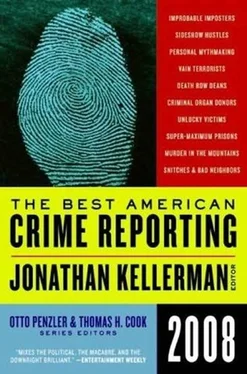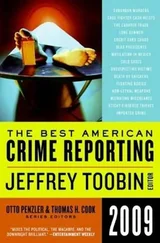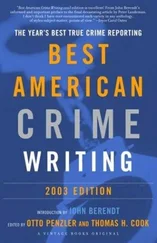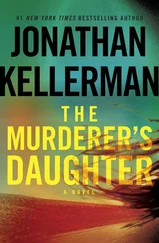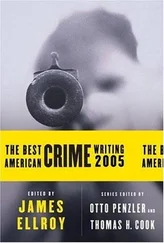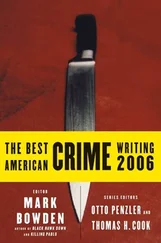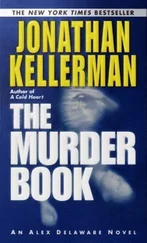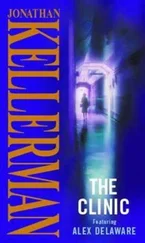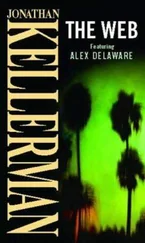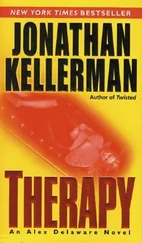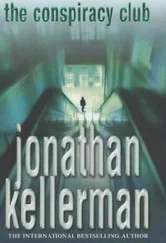Staring down almost a decade behind bars can change a man, make him long for a second chance. And now it seemed Dowery had been given one. In October 2004, he had cut a deal, agreeing to become a witness in a murder trial. In exchange for his testimony, and as a result of good behavior, the feds had eased the terms of his pretrial detention. He had entered a drug-treatment program and landed a job working the graveyard shift at a condiment factory in the suburbs. For the first time in years, he was clean and sober, and life was looking up.
Each night, Dowery rode the commuter rail from the city to the plant; each morning, he rode it home again. He didn’t mind the odd hours; having worked as a baker, he was accustomed to being nocturnal. Shortly after dawn on October 19, 2005, he got off the train as usual. It was a brisk morning, with clouds dappling the sky but no hint of rain. He decided to skip the bus and walk the mile to his house on Bartlett Avenue.
He ambled past the massive Board of Education building, with its columns, and headed down North Avenue to Greenmount Cemetery. There he turned left, passing the abandoned row houses where the “corner boys” were already opening for business, hoping to find a junkie in need of a morning fix. Farther on, past still-shuttered hair salons and check-cashing outfits, he turned down East 24th toward Bartlett. Just after seven o’clock, he reached his front porch and called out for his girlfriend, Yolanda, to let him in. Then he sensed something behind him.
He spun around to find two men dressed in black standing in his small front yard. One held a gun. As Dowery scrambled for his neighbor’s porch, the man pulled the trigger. Dowery leaped from the porch and raced around the side of his house, the two men close behind him, the gunman firing the whole way. He managed to stagger through his back door before his legs gave out. The attackers, believing their work accomplished, took off. A neighbor would later tell police that she heard one of them say, “We busted his motherfucking ass.”
Dowery had been shot in the back and in both arms and legs-six times in all. Only the skilled hands of the surgeons at Johns Hopkins spared his life. And yet, in the eyes of many people in the blocks around Bartlett, John Dowery had gotten what was coming to him.
IN MANY BALTIMORE NEIGHBORHOODS, talking to the law has become a mortal sin, a dishonorable act punishable by social banishment-or worse. Prosecutors in the city can rattle off a litany of brutal retaliations: houses firebombed, witnesses and their relatives shot, contract hits on 10-year-olds. Witness intimidation, they say, badly hampers their ability to fight crime, and it affects nearly every murder case they try.
Prosecutors in most major U.S. cities tell similar stories. Two years ago in Philadelphia, a drug kingpin was convicted of witness intimidation after he was taped threatening to kill those who testified against him. Five relatives of one witness in the case had already died, in a house fire that prosecutors believe was the drug lord’s doing. Last year in San Francisco, two gang members beat a murder rap after the state’s star witness turned up dead. Several years ago in Denver, a key homicide witness was sexually assaulted in what prosecutors believe was a “contract” attack designed to frighten him out of testifying.
Police and prosecutors have been contending with reluctant witnesses for decades. But according to law-enforcement experts, the problem is getting dramatically worse, and is reflected in falling arrest and conviction rates for violent crimes. In cities with populations between half a million (for example, Tucson) and a million (Detroit), the proportion of violent crimes cleared by an arrest dropped from about 45 percent in the late 1990s to less than 35 percent in 2005, according to the FBI. Conviction rates have similarly dropped. At the same time, crime has spiked. Murder rates have risen more or less steadily since 2000. Last December, the FBI voiced concern over a jump in violent crime, which in 2005 showed its biggest increase in more than a decade.
The reasons for witnesses’ reluctance appear to be changing and becoming more complex, with the police confronting a new cultural phenomenon: the spread of the gangland code of silence, or omerta , from organized crime to the population at large. Those who cooperate with the police are labeled “snitches” or “rats”-terms once applied only to jailhouse informants or criminals who turned state’s evidence, but now used for “civilian” witnesses as well. This is particularly true in the inner cities, where gangsta culture has been romanticized through rap music and other forms of entertainment, and where the motto “Stop snitching,” expounded in hip-hop lyrics and emblazoned on caps and T-shirts, has become a creed.
The metastasis of this culture of silence in minority communities has been facilitated by a gradual breakdown of trust in the police and the government. The erosion began during the civil-rights era, when informants were a favorite law-enforcement tool against groups like the Black Panthers. But it accelerated because of the war on drugs. David Kennedy, the director of the Center for Crime Prevention and Control at the John Jay College of Criminal Justice, in New York, told me: “This is the reward we have reaped for 20 years of profligate drug enforcement in these communities.” When half the young black men in a neighborhood are locked up, on bail, or on parole, the police become the enemy. Add to this the spread of racialized myths-that crack was created by the CIA to keep blacks in their place, for example-and you get a toxic mix. Kennedy thinks the silence of many witnesses doesn’t come from fear, but from anger.
The growing culture of silence helps to legitimize witness intimidation. At the same time, criminals have become more adept at enforcing the code, using increasingly sophisticated methods to bribe, intimidate, and harm witnesses. Defendants and their surrogates have obtained witnesses’ supposedly confidential grand-jury testimony and tacked it to their doors, along with threatening notes. They have adopted new technology like cell-phone cameras and text-messaging to spread the word about who is snitching; threats have even been text-messaged to the phones of sequestered witnesses. And every incident in which a witness is assaulted or murdered heightens the climate of fear and mistrust-the sense that the law either can’t or won’t protect ordinary people.
ON OCTOBER 13, 2004, a year before he was shot while returning home from work, John Dowery was still electronically shackled to his house. Sometime after 3 p.m. that day, he looked out his front window and saw his friend James Wise coming up the street. Dowery and Wise, whom everyone called Jay, shared a love of basketball-and of heroin. Today Jay was with a younger man Dowery didn’t recognize. They stopped outside the chain-link fence around Dowery’s front yard. Jay called to Dowery, then came up to the door. He seemed nervous. He wanted Dowery’s advice.
Jay said the other man had a gun. They were planning to rob an old drug dealer named Reds, who operated from a vacant lot a few doors down. Dowery told him it was a bad idea. At 40, Jay was no innocent, but neither was he an experienced stickup artist. Even if the two men could pull off the robbery, stickup boys in East Baltimore don’t usually live long: On the street, robbing a dealer is a capital offense. “I told him basically not to do it,” Dowery would later say. “But he ain’t listen.”
Dowery looked on from his front door as the two men walked down the street and entered the “cut” where Reds worked. He watched a flock of dope fiends suddenly flee the alley, like ducks flushed from the reeds. Seconds later, Reds darted out too. Then Jay and his partner emerged and raced down the street.
Читать дальше
